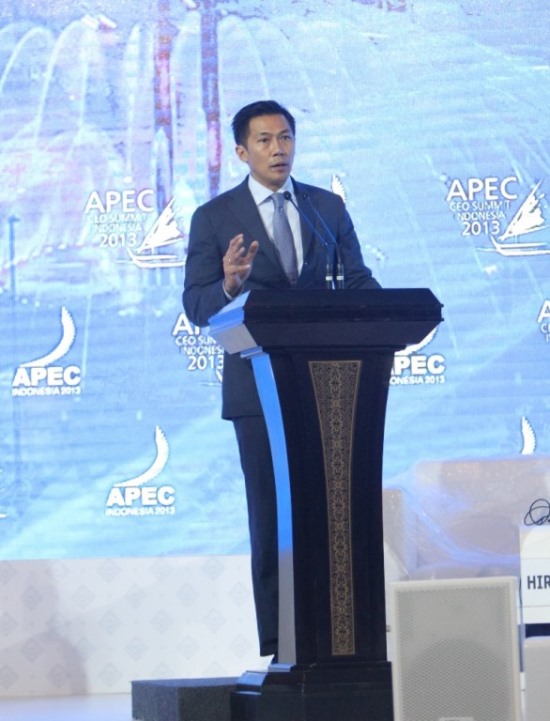|
Collaborative Work Systems
A collaborative working environment (CWE) supports people, such as e-professionals, in their individual and cooperative work. Research in CWE involves focusing on organizational, technical, and social issues. Background Working practices in a collaborative working environment evolved from the traditional or geographical co-location paradigm. In a CWE, professionals work together regardless of their geographical location. In this context, e-professionals use a collaborative working environment to provide and share information and exchange views in order to reach a common understanding. Such practices enable an effective and efficient collaboration among different proficiencies. Description The following applications or services are considered elements of a CWE: * E-mail * Instant messaging * Application sharing * Video conferencing * Collaborative workspace, document management and version control system * Task and workflow management * Wiki group or community effort to edit w ... [...More Info...] [...Related Items...] OR: [Wikipedia] [Google] [Baidu] |
E-professional
E-professional or "eprofessional" or even "eProfessional" is a term used in Europe to describe a professional whose work relies on concepts of remote work: working at a distance using information technology and communications technology, as well as online collaboration (i.e. virtual team, mass collaboration, massively distributed collaboration, online community of practice such as the open source community, and open innovation principles. The concept of e-professional, strongly related to the concept of remote work, extends the traditional concept of professional in including any type of expert or knowledge worker intensively using Information and Communications Technology, ICT (Information and Communications Technology) environments and toolsM.A. Martinez Carreras, A.F. Gomez Skarmeta,2006Towards Interoperability in Collaborative Environments/ref> in their working practices. An eprofessional is a member of at least one community of practice which confers him the title of professi ... [...More Info...] [...Related Items...] OR: [Wikipedia] [Google] [Baidu] |
Mass Collaboration
Mass collaboration is a form of collective action that occurs when large numbers of people work independently on a single project, often modular in its nature. Such projects typically take place on the internet using social software and computer-supported collaboration tools such as wiki technologies, which provide a potentially infinite hypertextual substrate within which the collaboration may be situated. Open source software such as Linux was developed via mass collaboration. Factors Modularity Modularity enables a mass of experiments to proceed in parallel, with different teams working on the same modules, each proposing different solutions. Modularity allows different "blocks" to be easily assembled, facilitating decentralised innovation that all fits together. Differences Cooperation Mass collaboration differs from mass cooperation in that the creative acts taking place require the joint development of shared understandings. Conversely, group members involved in cooperati ... [...More Info...] [...Related Items...] OR: [Wikipedia] [Google] [Baidu] |
Integrated Collaboration Environment
An integrated collaboration environment (ICE) is an environment in which a virtual team does its work. Such environments allow companies to realize a number of competitive advantages by using their existing computers and network infrastructure for group and personal collaboration. These fully featured environments combine the best features of web-based conferencing and collaboration, desktop videoconferencing, and instant message into a single easy-to-use, intuitive environment. Recent developments have allowed companies include streaming in real-time and archived modes into their ICE. Common applications found within ICE are: #''Collaborative software'' designed to improve the performance of teams by supporting the sharing and flow of information. It allows for real-time collaboration and conferencing. #''Workflow systems'' facilitate the automation and management of business processes. #''Documentation management systems'' manage a document through all the stages of its process ... [...More Info...] [...Related Items...] OR: [Wikipedia] [Google] [Baidu] |
Collaborative Software
Collaborative software or groupware is application software designed to help people working on a common task to attain their goals. One of the earliest definitions of groupware is "intentional group processes plus software to support them". As regards available interaction, collaborative software may be divided into: real-time collaborative editing platforms that allow multiple users to engage in live, simultaneous and reversible editing of a single file (usually a document), and version control (also known as revision control and source control) platforms, which allow separate users to make parallel edits to a file, while preserving every saved edit by every user as multiple files (that are variants of the original file). Collaborative software is a broad concept that overlaps considerably with computer-supported cooperative work (CSCW). According to Carstensen and Schmidt (1999) groupware is part of CSCW. The authors claim that CSCW, and thereby groupware, addresses "how colla ... [...More Info...] [...Related Items...] OR: [Wikipedia] [Google] [Baidu] |
Computer Supported Cooperative Work
Computer-supported cooperative work (CSCW) is the study of how people utilize technology collaboratively, often towards a shared goal. CSCW addresses how computer systems can support collaborative activity and coordination. More specifically, the field of CSCW seeks to analyze and draw connections between currently understood human psychological and social behaviors and available collaborative tools, or groupware. Often the goal of CSCW is to help promote and utilize technology in a collaborative way, and help create new tools to succeed in that goal. These parallels allow CSCW research to inform future design patterns or assist in the development of entirely new tools. History The origins of CSCW as a field are intertwined with the rise and subsequent fall of office automation as response to some of the criticisms, particularly the failure to address the impact human psychological and social behaviors can have. Greif and Cashman created the term CSCW to help employees seeking ... [...More Info...] [...Related Items...] OR: [Wikipedia] [Google] [Baidu] |
Motivation
Motivation is the reason for which humans and other animals initiate, continue, or terminate a behavior at a given time. Motivational states are commonly understood as forces acting within the agent that create a disposition to engage in goal-directed behavior. It is often held that different mental states compete with each other and that only the strongest state determines behavior. This means that we can be motivated to do something without actually doing it. The paradigmatic mental state providing motivation is desire. But various other states, such as beliefs about what one ought to do or intentions, may also provide motivation. Motivation is derived from the word 'motive', which denotes a person's needs, desires, wants, or urges. It is the process of motivating individuals to take action in order to achieve a goal. The psychological elements fueling people's behavior in the context of job goals might include a desire for money. Various competing theories have been proposed co ... [...More Info...] [...Related Items...] OR: [Wikipedia] [Google] [Baidu] |
Leadership
Leadership, both as a research area and as a practical skill, encompasses the ability of an individual, group or organization to "lead", influence or guide other individuals, teams, or entire organizations. The word "leadership" often gets viewed as a contested term. Specialist literature debates various viewpoints on the concept, sometimes contrasting Eastern and Western approaches to leadership, and also (within the West) North American versus European approaches. U.S. academic environments define leadership as "a process of social influence in which a person can enlist the aid and support of others in the accomplishment of a common and ethical task". Basically, leadership can be defined as an influential power-relationship in which the power of one party (the "leader") promotes movement/change in others (the "followers"). Some have challenged the more traditional managerial views of leadership (which portray leadership as something possessed or owned by one individual due ... [...More Info...] [...Related Items...] OR: [Wikipedia] [Google] [Baidu] |
Environment (systems)
In science and engineering, a system is the part of the universe that is being studied, while the environment is the remainder of the universe that lies outside the boundaries of the system. It is also known as the surroundings or neighborhood, and in thermodynamics, as the reservoir. Depending on the type of system, it may interact with the environment by exchanging mass, energy (including heat and work), linear momentum, angular momentum, electric charge, or other conserved properties. In some disciplines, such as information theory, information may also be exchanged. The environment is ignored in analysis of the system, except in regard to these interactions. See also *Bioenergetic systems - energy system *Earth system science *Environment (biophysical) * Environmental Management System *Thermodynamic system A thermodynamic system is a body of matter and/or radiation, confined in space by walls, with defined permeabilities, which separate it from its surroundings. The ... [...More Info...] [...Related Items...] OR: [Wikipedia] [Google] [Baidu] |
Collaborative Workspace
Coworking is an arrangement in which workers for different companies share an office space. It allows cost savings and convenience through the use of common infrastructures, such as equipment, utilities and receptionist and custodial services, and in some cases refreshments and parcel acceptance services. It is attractive to independent contractors, independent scientists, remote workers, digital nomads, and people who travel frequently. Additionally, coworking helps workers avoid the feeling of social isolation they may experience while remote working or traveling and eliminate distractions in home office. Most coworking spaces charge membership dues. Major companies that provide coworking space and serviced offices include WeWork and IWG plc. Types Coworking is not only about providing a physical place, but also about establishing a community. Its rapid growth has been seen as a possible way for city planners to address the decline of high street retail in urban centres. Its be ... [...More Info...] [...Related Items...] OR: [Wikipedia] [Google] [Baidu] |
Open Innovation
Open innovation is a term used to promote an information age mindset toward innovation that runs counter to the secrecy and silo mentality of traditional corporate research labs. The benefits and driving forces behind increased openness have been noted and discussed as far back as the 1960s, especially as it pertains to interfirm cooperation in R&D. Use of the term 'open innovation' in reference to the increasing embrace of external cooperation in a complex world has been promoted in particular by Henry Chesbrough, adjunct professor and faculty director of the Center for Open Innovation of the Haas School of Business at the University of California, and Maire Tecnimont Chair of Open Innovation at Luiss. The term was originally referred to as "a paradigm that assumes that firms can and should use external ideas as well as internal ideas, and internal and external paths to market, as the firms look to advance their technology". More recently, it is defined as "a distributed innova ... [...More Info...] [...Related Items...] OR: [Wikipedia] [Google] [Baidu] |
Open Source
Open source is source code that is made freely available for possible modification and redistribution. Products include permission to use the source code, design documents, or content of the product. The open-source model is a decentralized software development model that encourages open collaboration. A main principle of open-source software development is peer production, with products such as source code, blueprints, and documentation freely available to the public. The open-source movement in software began as a response to the limitations of proprietary code. The model is used for projects such as in open-source appropriate technology, and open-source drug discovery. Open source promotes universal access via an open-source or free license to a product's design or blueprint, and universal redistribution of that design or blueprint. Before the phrase ''open source'' became widely adopted, developers and producers have used a variety of other terms. ''Open source'' gained ... [...More Info...] [...Related Items...] OR: [Wikipedia] [Google] [Baidu] |


